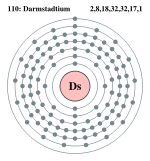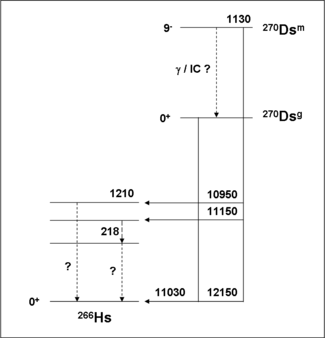Darmstadtium
2008/9 Schools Wikipedia Selection. Related subjects: Chemical elements
|
||||||||||||||||||||||||||||||||||||||||||||||||||||||||||||||||
| General | ||||||||||||||||||||||||||||||||||||||||||||||||||||||||||||||||
|---|---|---|---|---|---|---|---|---|---|---|---|---|---|---|---|---|---|---|---|---|---|---|---|---|---|---|---|---|---|---|---|---|---|---|---|---|---|---|---|---|---|---|---|---|---|---|---|---|---|---|---|---|---|---|---|---|---|---|---|---|---|---|---|---|
| Name, Symbol, Number | darmstadtium, Ds, 110 | |||||||||||||||||||||||||||||||||||||||||||||||||||||||||||||||
| Element category | transition metals | |||||||||||||||||||||||||||||||||||||||||||||||||||||||||||||||
| Group, Period, Block | 10, 7, d | |||||||||||||||||||||||||||||||||||||||||||||||||||||||||||||||
| Appearance | unknown, probably silvery white or metallic gray |
|||||||||||||||||||||||||||||||||||||||||||||||||||||||||||||||
| Standard atomic weight | [281] g·mol−1 | |||||||||||||||||||||||||||||||||||||||||||||||||||||||||||||||
| Electron configuration | perhaps [Rn] 5f14 6d9 7s1 (in analogy to platinum) |
|||||||||||||||||||||||||||||||||||||||||||||||||||||||||||||||
| Electrons per shell | 2, 8, 18, 32, 32, 17, 1 | |||||||||||||||||||||||||||||||||||||||||||||||||||||||||||||||
| Phase | presumably a solid | |||||||||||||||||||||||||||||||||||||||||||||||||||||||||||||||
| CAS registry number | 54083-77-1 | |||||||||||||||||||||||||||||||||||||||||||||||||||||||||||||||
| Selected isotopes | ||||||||||||||||||||||||||||||||||||||||||||||||||||||||||||||||
|
||||||||||||||||||||||||||||||||||||||||||||||||||||||||||||||||
| References | ||||||||||||||||||||||||||||||||||||||||||||||||||||||||||||||||
Darmstadtium (pronounced /dɑrmˈʃtætiəm/), formerly known as Ununnilium, is a chemical element with the symbol Ds and atomic number 110.
This synthetic element is one of the so-called super-heavy atoms. It decays quickly: Heavier isotopes of darmstadtium have half-lives on the order of ten seconds.
Official discovery
Darmstadtium was first created on November 9, 1994 at the Gesellschaft für Schwerionenforschung (GSI) in Wixhausen, a northern suburb of Darmstadt, Germany by Peter Armbruster and Gottfried Münzenberg, under the direction of professor Sigurd Hofmann. Four atoms of it were detected by a nuclear fusion reaction caused by bombarding a lead-208 target with nickel-62 ions:
In the same series of experiments, the same team also carried out the reaction using heavier nickel-64 ions. During two runs, 9 atoms of 271Ds were convincingly detected by correlation with known daughter decay properties:
The IUPAC/IUPAP Joint Working Party (JWP) recognised the GSI team as discoverers in their 2001 report.
Proposed names
Element 110 was first given the temporary name ununnilium (/ˌjuːnəˈnɪliəm/ or /ˌʌnəˈnɪliəm/, symbol Uun). Once recognized as discoverers, the team at GSI considered the names darmstadtium (Ds) and wixhausium (Wi) for element 110. They decided on the former and named the element after the city near the place of its discovery, Darmstadt and not the suburb Wixhausen itself. The new name was officially recommended by IUPAC on August 16, 2003.
The element has also earned the nickname of policium, because the telephone number of the police is 110 within Germany.
Electronic structure
Darmstadtium is element 110 in the Periodic Table. The two forms of the projected electronic structure are:
Bohr model: 2, 8, 18, 32, 32, 17, 1
Quantum mechanical model: 1s22s22p63s23p64s23d10 4p65s24d105p66s24f145d10 6p67s15f146d9
Extrapolated chemical properties of eka-platinum/dvi-palladium
Oxidation states
Element 110 is projected to be the eighth member of the 6d series of transition metals and the heaviest member of group 10 in the Periodic Table, below nickel, palladium and platinum. The highest confirmed oxidation state of +VI is shown by platinum whilst the +IV state is stable for both elements. Both elements also possess a stable +II state. Darmstadtium is therefore predicted to show oxidation states +VI, +IV and +II.
Chemistry
High oxidation states are expected to become more stable as the group is descended, so darmstadtium is expected to form a stable hexafluoride, DsF6, in addition to DsF5 and DsF4. Halogenation should result in the formation of the tetrahalides, DsCl4, DsBr4 and DsI4.
Like other Group 10 elements, darmstadtium can be expected to have notable hardness and catalytic properties.
History of synthesis of isotopes by cold fusion
208Pb(64Ni,xn)272-xDs (x=1)
This reaction was first studied by scientists at GSI in 1986, without success. A cross section limit of 12 pb was calculated. After an upgrade of their facilities, they successfully detected 9 atoms of 271Ds in two runs in 1994 as part of their discovery experiments on element 110. This reaction was successfully repeated in 2000 by GSI (4 atoms), in 2000 and 2004 by LBNL (9 atoms in total) and in 2002 by RIKEN (14 atoms). The summation of the data allowed a measurement of the 1n neutron evaporation excitation function.
207Pb(64Ni,xn)271-xDs (x=1)
In addition to the official discovery reactions, in October-November 2000, the team at GSI also studied the reaction using a Pb-207 target in order to search for the new isotope 270Ds. They succeeded in synthesising 8 atoms of 270Ds, relating to a ground state isomer, 270gDs, and a high-spin K-isomer, 270mDs.
208Pb(62Ni,xn)270-xDs (x=1)
The GSI team studied this reaction in 1994 as part of their discovery experiment. Three atoms of 269Ds were detected. A fourth decay chain was measured but subsequently retracted.
209Bi(59Co,xn)268-xDs
This reaction was first studied by the team at Dubna in 1986. They were unable to detect any product atoms and measured a cross section limit of 1 pb. In 1995, the team at LBNL reported that they had succeeded in detecting a single atom of 267Ds from the 1n neutron evaporation channel. However, several decays were missed and further research is required to confirm this discovery.
History of synthesis of isotopes by hot fusion
232Th(48Ca,xn)280-xDs
The synthesis of element 110 by hot fusion pathways was first attempted in 1986 by the team at Dubna. Using the method of detection of spontaneous fission, they were unable to measure any SF activities and calculated a cross section limit of 1 pb for the decay mode. In three separate experiments between November 1997 and October 1998, the same team re-studied this reaction as part of their new 48Ca program on the synthesis of superheavy elements. Several SF activities with relatively long half-lives were detected and tentatively assigned to decay of the daughters 269Sg or 265Rf, with a cross section of 5 pb. These observations have not been confirmed and the results are taken as only an indication for the synthesis of darmstadtium in this reaction.
232Th(44Ca,xn)276-xDs
This reaction was attempted in 1986 and 1987 by the Dubna team. In both experiments, a 10 ms SF activities was measured and assigned to 272Ds, with a calculated cross section of 10 pb. This activity is currently not thought to be due to a darmstadtium isotope.
238U(40Ar,xn)278-xDs
This reaction was first attempted by the Dubna team in 1987. Only spontaneous fission from the transfer products 240mfAm and 242mfAm were observed and the team calculated a cross section limit of 1.6 pb. The team at GSI first studied this reaction in 1990. Once again, no atoms of element 110 could be detected. In August 2001, the GSI repeated reaction, without success, and calculated a cross section limit of 1.0 pb.
236U(40Ar,xn)276-xDs
This reaction was first attempted by the Dubna team in 1987. No spontaneous fission was observed.
235U(40Ar,xn)275-xDs
This reaction was first attempted by the Dubna team in 1987. No spontaneous fission was observed. It was further studied in 1990 by the GSI team. Once again, no atoms were detected and a cross section limit of 21 pb was calculated.
233U(40Ar,xn)273-xDs
This reaction was first studied in 1990 by the GSI team. No atoms were detected and a cross section limit of 21 pb was calculated.
244Pu(34S,xn)278-xDs (x=5)
In September 1994 the team at Dubna detected a single atom of 273Ds, formed in the 5n neutron evaporation channel. The measured cross section was just 400 fb.
Synthesis of isotopes as decay products
Isotopes of darmstadtium have also been detected in the decay of heavier elements. Observations to date are shown in the table below:
| Evaporation Residue | Observed Ds isotope |
|---|---|
| 293116 , 289114 | 281Ds |
| 291116 , 287114 , 283112 | 279Ds |
| 277112 | 273Ds |
In some experiments, the decay of 293116 and 289114 produced an isotope of darmstadtium decaying by emission of an 8.77 MeV alpha particle with a half life of 3.7 minutes. Although unconfirmed, it is highly possible that this activity is associated with a meta-stable isomer, namely 281mDs.
Spectroscopy of darmstadtium isotopes
270Ds
Chronology of isotope discovery
| Isotope | Year discovered | discovery reaction |
|---|---|---|
| 267Ds | 1994? | 209Bi(59Co,n) |
| 268Ds | unknown | |
| 269Ds | 1994 | 208Pb(62Ni,n) |
| 270Dsg,m | 2000 | 207Pb(64Ni,n) |
| 271Dsg,m | 1994 | 208Pb(64Ni,n) |
| 272Ds | unknown | |
| 273Ds | 1996 | 244Pu(34S,5n) |
| 274Ds | unknown | |
| 275Ds | unknown | |
| 276Ds | unknown | |
| 277Ds | 1997? | 232Th(48Ca,3n) |
| 278Ds | unknown | |
| 279Ds | 2002 | 244Pu(48Ca,5n) |
| 280Ds | unknown | |
| 281Ds | 1999? , 2002 | 244Pu(48Ca,3n) |
Chemical yields of isotopes
Cold fusion
The table below provides cross-sections and excitation energies for cold fusion reactions producing darmstadtium isotopes directly. Data in bold represents maxima derived from excitation function measurements. + represents an observed exit channel.
| Projectile | Target | CN | 1n | 2n | 3n |
|---|---|---|---|---|---|
| 62Ni | 208Pb | 270Ds | 3.5 pb | ||
| 64Ni | 208Pb | 272Ds | 15 pb , 9.9 MeV |
Isomerism in darmstadtium nuclides
281Ds
The production of 281Ds by the decay of 289114 or 293116 has produced two very conflicting decay modes. The most common and readily confirmed mode is SF with a half-life of 11 s. A much rarer and hitherto unconfirmed mode is alpha decay by emission of an 8.77 MeV alpha particle with an observed half-life of ~3.7 m. This decay is associated with a unique decay pathway from the parent nuclides and must be assigned to an isomeric level. The half-life suggests that it must be assigned to a meta-stable state but further research is required to confirm these reports.
271Ds
Decay data from the direct synthesis of 271Ds clearly indicates the presence of two alpha groups. The first has alpha lines at 10.74 and 10.69 MeV with a half-life of 1.63 ms. The other has a single alpha line at 10.71 MeV with a half-life of 69 ms. The first has been assigned to the ground state and the latter to an isomeric level. It has been suggested that the closeness of the alpha decay energies indicates that the isomeric level may decay primarily by delayed gamma emission to the ground state, resulting in an identical measured alpha energy and a combined half-life for the two processess.
270Ds
The direct production of 270Ds has clearly identified two alpha groups belonging to two isomeric levels. The ground state decays into the ground state of 266Hs by emitting an 11.03 MeV alpha particle with a half-life of 0.10 ms. The isomeric level decays by alpha emission with alpha lines at 12.15,11.15 and 10.95 MeV with a half-life of 6 ms. The 12.15 MeV has been assigned as decay into the ground state of 266Hs indicating that this high spin K-isomer lies at 1.12 MeV above the ground state.
Retracted isotopes
280Ds
The first synthesis of element 114 resulted in two atoms assigned to 288114, decaying to the 280Ds which underwent spontaneous fission. The assignment was later changed to 289114 and the darmstadtium isotope to 281Ds. Hence, 280Ds is currently unknown.
277Ds
In the claimed synthesis of 293118 in 1999, the isotope 277Ds was identified as decaying by 10.18 MeV alpha emission with a half-life of 3.0 ms. This claim was retracted in 2001 and thus this darmstadtium isotope is currently unknown or unconfirmed.
273mDs
In the synthesis of 277112 in 1996 by GSI (see ununbium), one decay chain proceeded via 273Ds which decayed by emission of a 9.73 MeV alpha particle with a lifetime of 170 ms. This would have been assigned to an isomeric level. This data could not be confirmed and thus this isotope is currently unknown or unconfirmed.
272Ds
In the first attempt to synthesise element 110, a 10 ms SF activity was assigned to 272Ds in the reaction 232Th(44Ca,4n). Given current understanding regarding stability, this isotope has been retracted from the Table of Isotopes.
Theoretical calculation in a quantum tunneling model reproduces the experimental alpha decay half live data. It also predicts that the isotope 294110 would have alpha decay half life of the order of 311 years.




